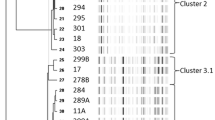Abstract
The rapid identification of patients colonized with carbapenem-resistant Enterobacterales (CRE) is important for infection control purposes. Here, we compared and evaluated nine different agars for the detection of carbapenemase-producing Enterobacterales (CPE) from clinical samples. In the study, 69 CPE and 40 carbapenemase-negative isolates were included. Overall, seven commercially available screening agars were assessed: Brilliance CRE (Oxoid), Chromatic CRE (Liofilchem), chromID CARBA and chromID OXA-48 (both bioMérieux), three ESBL agars (Chromatic ESBL [Liofilchem], chromID ESBL [bioMérieux], Brilliance ESBL [Oxoid]), and two agars produced in-house (McCARB and McCARB-T). The sensitivity of CRE agars for CPE detection ranged from 34.8 to 98.6%. Brilliance CRE and McCARB/McCARB-T showed the overall highest sensitivity (98.6 and 97.1%, respectively). OXA-48 producers were the most difficult to detect; only 4/9 agars detected all isolates (McCARB/McCARB-T, Chromatic CRE, ChromID OXA-48). Additionally, all ESBL-negative OXA-48 isolates failed to grow on ESBL screening agars. Specificity ranged from 30 (Brilliance ESBL) to 100% (ChromID OXA-48). The limit of detection for different CPE in spiked stool samples ranged from 1.5 × 101 to 1.5 × 103 CFU/ml. Overall, Brilliance CRE and the McCARB in-house agars showed the best performance and were able to detect most CPE, including almost all OXA-48. ESBL agars were not suitable for detection of CPE alone, as OXA-48 isolates negative for ESBL were suppressed. The highest sensitivity was achieved by a combination of a CRE agar and an ESBL agar.
Similar content being viewed by others
References
Lutgring JD, Limbago BM (2016) The problem of carbapenemase-producing-carbapenem-resistant-Enterobacteriaceae detection. J Clin Microbiol 54:529–534
Grundmann H, Glasner C, Albiger B et al (2017) Occurrence of carbapenemase-producing Klebsiella pneumoniae and Escherichia coli in the European survey of carbapenemase-producing Enterobacteriaceae (EuSCAPE): a prospective, multinational study. Lancet Infect Dis 17:153–163
Jazmati N, Hein R, Hamprecht A (2016) Use of an enrichment broth improves detection of extended-Spectrum-Beta-lactamase-producing Enterobacteriaceae in clinical stool samples. J Clin Microbiol 54:467–470
Pence MA, Hink T, Burnham C-AD (2015) Comparison of chromogenic media for recovery of carbapenemase-producing Enterobacteriaceae (CPE) and evaluation of CPE prevalence at a tertiary care academic medical center. J Clin Microbiol 53:663–666
Papadimitriou-Olivgeris M, Bartzavali C, Christofidou M et al (2014) Performance of chromID® CARBA medium for carbapenemases-producing Enterobacteriaceae detection during rectal screening. Eur J Clin Microbiol Infect Dis 33:35–40
Koroska F, Göttig S, Kaase M, Steinmann J, Gatermann S, Sommer J, Wille T, Plum G, Hamprecht A (2017) Comparison of phenotypic tests and an immunochromatographic assay and development of a new algorithm for detection of OXA-48-like carbapenemases. J Clin Microbiol 55:877–883
Saleh A, Göttig S, Hamprecht AG (2018) Multiplex immunochromatographic detection of OXA-48, KPC, and NDM carbapenemases: impact of inoculum, antibiotics, and agar. J Clin Microbiol 56:e00050–e00018. https://doi.org/10.1128/JCM.00050-18
Hamprecht A, Vehreschild JJ, Seifert H, Saleh A (2018) Rapid detection of NDM, KPC and OXA-48 carbapenemases directly from positive blood cultures using a new multiplex immunochromatographic assay. PLoS One 13:e0204157
Hamprecht A, Poirel L, Göttig S, Seifert H, Kaase M, Nordmann P (2013) Detection of the carbapenemase GIM-1 in Enterobacter cloacae in Germany. J Antimicrob Chemother 68:558–561
Baeza LL, Pfennigwerth N, Greissl C, Göttig S, Saleh A, Stelzer Y, Gatermann SG, Hamprecht A (2019) Comparison of five methods for detection of carbapenemases in Enterobacterales with proposal of a new algorithm. Clin Microbiol Infect. https://doi.org/10.1016/j.cmi.2019.03.003
Pfennigwerth N (2018) Bericht des Nationalen Referenzzentrums (NRZ) für gramnegative Krankenhauserreger – Zeitraum 1. Januar 2017–31. Dezember 2017. Epidemiol Bull 28:263–267. https://doi.org/10.17886/EpiBull-2018-034
Carbapenem-resistant Enterobacteriaceae (CRE) Control and Prevention Toolkit (2014). Available at: https://www.ahrq.gov/hai/patient-safety-resources/cre-toolkit/index.html. Last accessed: 2nd September 2019
Viau R, Frank KM, Jacobs MR, Wilson B, Kaye K, Donskey CJ, Perez F, Endimiani A, Bonomo RA (2016) Intestinal carriage of carbapenemase-producing organisms: current status of surveillance methods. Clin Microbiol Rev 29(1):1–27. https://doi.org/10.1128/CMR.00108-14
Girlich D, Poirel L, Nordmann P (2013) Comparison of the SUPERCARBA, CHROMagar KPC, and brilliance CRE screening media for detection of Enterobacteriaceae with reduced susceptibility to carbapenems. Diagn Microbiol Infect Dis 75(2):214–217. https://doi.org/10.1016/j.diagmicrobio.2012.10.006
Hinić V, Amrein I, Stammler S, Heckendorn J, Meinel D, Frei R, Egli A (2017) Comparison of two rapid biochemical tests and four chromogenicselective media for detection of carbapenemase-producing gram-negative bacteria. J Microbiol Methods 135:66–68. https://doi.org/10.1016/j.mimet.2017.01.012
Acknowledgments
We thank Anne Brunke and Marco Schwabe for excellent technical assistance. We are furthermore grateful to ThermoFisher, BioMérieux, Liofilchem for providing agars at reduced prices or free of charge.
Author information
Authors and Affiliations
Corresponding author
Ethics declarations
Conflict of interest
The authors declare that they have no conflict of interest.
Additional information
Publisher’s note
Springer Nature remains neutral with regard to jurisdictional claims in published maps and institutional affiliations.
Electronic supplementary material
ESM 1
(DOCX 55 kb)
Rights and permissions
About this article
Cite this article
Göttig, S., Walker, S.V., Saleh, A. et al. Comparison of nine different selective agars for the detection of carbapenemase-producing Enterobacterales (CPE). Eur J Clin Microbiol Infect Dis 39, 923–927 (2020). https://doi.org/10.1007/s10096-019-03786-7
Received:
Accepted:
Published:
Issue Date:
DOI: https://doi.org/10.1007/s10096-019-03786-7



